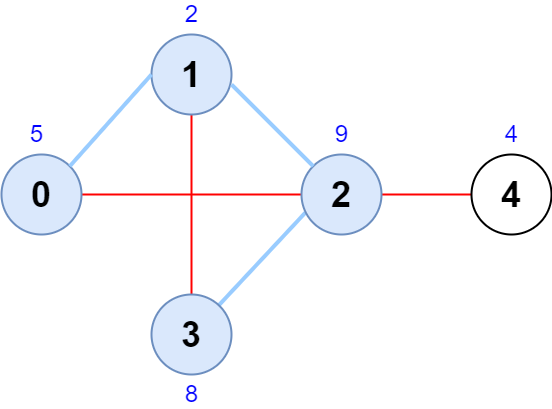2242 - Maximum Score of a Node Sequence (Hard)
Problem Link
https://leetcode.com/problems/maximum-score-of-a-node-sequence/
Problem Statement
There is an undirected graph with n nodes, numbered from 0 to n - 1.
You are given a 0-indexed integer array scores of length n where scores[i] denotes the score of node i. You are also given a 2D integer array edges where edges[i] = [ai, bi] denotes that there exists an undirected edge connecting nodes ai and bi.
A node sequence is valid if it meets the following conditions:
- There is an edge connecting every pair of adjacent nodes in the sequence.
- No node appears more than once in the sequence.
The score of a node sequence is defined as the sum of the scores of the nodes in the sequence.
Return the maximum score of a valid node sequence with a length of 4. If no such sequence exists, return __ -1.
Example 1:

Input: scores = [5,2,9,8,4], edges = [[0,1],[1,2],[2,3],[0,2],[1,3],[2,4]]
Output: 24
Explanation: The figure above shows the graph and the chosen node sequence [0,1,2,3].
The score of the node sequence is 5 + 2 + 9 + 8 = 24.
It can be shown that no other node sequence has a score of more than 24.
Note that the sequences [3,1,2,0] and [1,0,2,3] are also valid and have a score of 24.
The sequence [0,3,2,4] is not valid since no edge connects nodes 0 and 3.
Example 2:

Input: scores = [9,20,6,4,11,12], edges = [[0,3],[5,3],[2,4],[1,3]]
Output: -1
Explanation: The figure above shows the graph.
There are no valid node sequences of length 4, so we return -1.
Constraints:
n == scores.length4 <= n <= 5 * 10^41 <= scores[i] <= 10^80 <= edges.length <= 5 * 10^4edges[i].length == 20 <= ai, bi <= n - 1ai != bi- There are no duplicate edges.
Approach 1: Find the neighbours
The key idea is to find the best three neighbours for each node. We need to keep the order based on the scores. We can use priority queue but in C++ it is not convenient to iterate it at the end, instead we use set as it is sorted internally. After that, we just need to iterate them to find out all the combinations. However, we need to check if they are duplicate before updating the answer.
class Solution {
public:
int maximumScore(vector<int>& scores, vector<vector<int>>& edges) {
int n = scores.size();
// find the best neighbours (at most 3)
vector<set<pair<int, int>>> m(n);
for(auto x : edges) {
int u = x[0], v = x[1];
m[u].insert({scores[v], v});
m[v].insert({scores[u], u});
if (m[u].size() > 3) m[u].erase(m[u].begin());
if (m[v].size() > 3) m[v].erase(m[v].begin());
}
// iterate each combination to find the answer
int ans = -1;
for (auto x : edges) {
int u = x[0], v = x[1];
for (auto x1 : m[u]) {
for (auto x2 : m[v]) {
// skip some cases
if (x1.second != x2.second && x1.second != v && x2.second != u) {
ans = max(ans, scores[u] + scores[v] + x1.first + x2.first);
}
}
}
}
return ans;
}
};